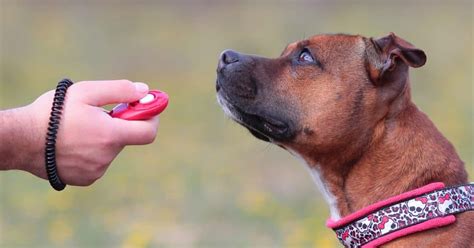Discover the essentials of clicker training for dogs, from choosing the right clicker to troubleshooting common issues. Incorporate this effective method into your daily routine.
Understanding the Clicker Training Method
Clicker training is a positive reinforcement method that uses a small handheld device called a clicker to communicate with your dog. The clicker emits a distinct sound that tells your dog when they have performed the desired behavior, and is usually followed by a treat or reward. This method is based on the principles of operant conditioning, where the dog learns to associate the sound of the clicker with a positive outcome. This technique has gained popularity in recent years and is widely used by dog trainers and pet owners alike.
One of the key concepts of clicker training is timing. It is important to click at the exact moment your dog performs the desired behavior, so they can make the connection between their action and the reward. This requires practice and precision, but can be highly effective in teaching new behaviors and shaping existing ones. Clicker training can be used to teach basic commands such as sit, stay, and come, as well as more complex tricks and behaviors.
Another important aspect of clicker training is consistency. It’s crucial to be consistent in your use of the clicker and rewards, as inconsistency can confuse your dog and hinder their learning progress. By using the clicker method consistently, you can effectively communicate with your dog and reinforce good behavior, ultimately strengthening your bond and improving obedience.
Choosing the Right Clicker for Your Dog
When it comes to training your dog, using a clicker can be a very effective tool. But with so many different options available, it’s important to choose the right clicker for your dog’s specific needs and preferences.
One important factor to consider when choosing a clicker is the sound it makes. Different clickers produce different sounds, and some dogs may respond better to a particular tone. It’s a good idea to test out a few different clickers to see which one your dog responds to best.
Another thing to consider is the size and shape of the clicker. You want to make sure it’s comfortable for you to hold and use, as well as easy for your dog to hear and recognize. Some clickers are designed to be smaller and more portable, while others may be larger and easier to handle.
Introducing the Clicker to Your Dog
When introducing the clicker to your dog, it’s important to start in a quiet, distraction-free environment. This will allow your dog to focus on the sound of the clicker and the training process. Begin by associating the clicker with positive reinforcement, such as treats or praise. Every time you click the clicker, immediately give your dog a treat. This will help your dog understand that the clicking sound means they have done something right.
It’s important to keep the training sessions short, especially in the beginning. Dogs have short attention spans, so keeping the sessions brief will help prevent them from becoming bored or distracted. Use the clicker to mark specific behaviors that you want to reinforce, such as sitting or staying. Remember to always follow the click with a reward to reinforce the desired behavior.
As your dog becomes more familiar with the clicker, you can start to use it in different situations and environments. This will help your dog understand that the clicker is a signal for good behavior, no matter where they are. With consistent practice and patience, your dog will learn to respond to the clicker and become more engaged in their training.
Basic Clicker Training Techniques
When it comes to basic clicker training techniques for your dog, the first step is to ensure that your dog knows what the clicker sound means. Start by simply clicking the clicker and then giving your dog a treat immediately afterwards. Repeat this process several times until your dog associates the clicker sound with getting a treat. This will set the foundation for using the clicker as a training tool.
Once your dog has made the association between the clicker sound and receiving a treat, you can begin using the clicker to reinforce desired behaviors. For example, if you are teaching your dog to sit, wait for them to naturally lower their rear end to the ground, then click the clicker and give them a treat. It’s important to click while the behavior is occurring, not after, to ensure that your dog understands which behavior is being rewarded.
Another important basic clicker training technique is to be consistent with your timing and use of the clicker. Click the instant the desired behavior occurs, and always follow up with a treat. Consistency and timing are key to effectively using the clicker as a training tool, so make sure to practice and refine your technique to ensure clear communication with your dog.
Advanced Clicker Training Strategies
Advanced Clicker Training Strategies
When it comes to advanced clicker training strategies for your dog, consistency is key. It’s important to maintain a regular training schedule, using the clicker to mark and reinforce desired behaviors consistently. This helps your dog understand what is expected of them and reinforces the training process.
Another important strategy is to gradually increase the difficulty of the tasks or behaviors you are asking your dog to perform. This can help keep your dog engaged and challenged, while also reinforcing their existing training and skills. By gradually increasing the difficulty, you can help your dog continue to learn and grow in their training.
Additionally, it’s important to keep training sessions short and focused, especially when working on advanced behaviors. Dogs have shorter attention spans, so keeping training sessions short and focused can help keep your dog engaged and prevent them from becoming overwhelmed or disinterested.
Troubleshooting Common Clicker Training Issues
Troubleshooting Common Clicker Training Issues
When using a clicker for dog training, there are several common issues that may arise. One of the most common problems is when the dog does not seem to understand the connection between the click and the desired behavior. This can be frustrating for both the owner and the dog, but there are steps that can be taken to troubleshoot this issue.
Another common issue is when the clicker itself becomes a distraction for the dog. Some dogs may become fixated on the sound of the clicker, and this can interfere with their ability to focus on the training session. It is important to address this issue and find ways to minimize the impact of the clicker on the dog’s behavior.
Finally, timing is a crucial aspect of clicker training, and many owners may struggle with getting the timing just right. If the click comes too late or too early, it can confuse the dog and make the training less effective. This is a common issue, but with practice and patience, it can be overcome.
Incorporating Clicker Training into Daily Routine
Clicker training is an effective method for teaching your dog new behaviors and reinforcing good habits. One of the key aspects of clicker training is consistency, and incorporating it into your daily routine can help make the training process more successful.
One way to incorporate clicker training into your daily routine is to set aside specific times each day for training sessions. This could be in the morning before work, in the evening after dinner, or whenever is most convenient for you. By making training a regular part of your day, you can help ensure that your dog receives consistent and ongoing instruction.
Another tip for incorporating clicker training into your daily routine is to use the clicker as a tool for reinforcing desired behaviors throughout the day. For example, if your dog responds well to the clicker during training sessions, you can use it to reward good behavior such as sitting quietly, walking nicely on a leash, or coming when called. By consistently using the clicker to reinforce positive actions, you can help your dog understand what is expected of them on a daily basis.
Frequently Asked Questions
What is a clicker in dog training?
A clicker is a small handheld device that makes a clicking sound when pressed. It is used as a marker to signal to the dog that they have performed the correct behavior and a reward is coming.
How does clicker training work?
Clicker training works by marking the precise moment when the dog performs the desired behavior, followed by giving a reward. This helps the dog understand which behavior is being rewarded.
What are the benefits of using a clicker for dog training?
Some benefits of using a clicker for dog training include clear communication with the dog, precise timing of marking desired behaviors, and the ability to shape complex behaviors.
Can any dog be trained using a clicker?
Yes, clicker training can be effective for a wide range of dog breeds and ages. It can be particularly useful for teaching new behaviors or refining existing ones.
Are there any potential drawbacks to clicker training?
Some dogs may find the sound of the clicker stressful or distracting. In these cases, an alternative marker such as a verbal cue or a different sound can be used.
What are some tips for effective clicker training?
Some tips for effective clicker training include keeping training sessions short and fun, using high-value rewards, and being consistent in marking and rewarding desired behaviors.
Can clicker training be used for more advanced training techniques?
Yes, clicker training can be used for advanced training techniques such as shaping, chaining behaviors, and even teaching complex tricks or agility exercises.





